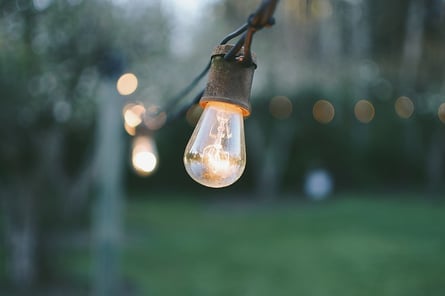 Dreaming of summer evenings in your new outdoor living room, or planning to entertain friends around the fire pit or fireplace on a chilly autumn night? If you’ve got a large backyard, chances are the fire-glow and your existing porch light aren’t going to be quite enough to help people navigate after sunset.
Dreaming of summer evenings in your new outdoor living room, or planning to entertain friends around the fire pit or fireplace on a chilly autumn night? If you’ve got a large backyard, chances are the fire-glow and your existing porch light aren’t going to be quite enough to help people navigate after sunset.
And besides, you’re proud of your beautiful outdoor living room—why not turn on a few spotlights to show it off?
So let’s talk about lighting for your outdoor living area. In our next post, we’ll cover the different types of lights and what each kind is best suited for. But today we’ll focus on the practical side—how are you going to get those lights turned on in the first place?
When it comes to power sources for outdoor lighting, you’ve got several options:
Solar lighting
In addition to being eco-friendly, solar-powered lights have a number of advantages. They’re easy to install since they require no wiring, they don’t affect your electricity bill, and they can turn themselves on automatically each night. High-quality solar lights can stay lit for several hours after sunset, provided it’s been a sunny day.
Granted, solar lights are not as bright as conventional lights, so they’re often best used for ambient light or to illuminate walkways. And once they dim, that’s it for the evening, so if you plan on entertaining late into the night you’ll probably want to have conventional electric lights as well.
Battery-powered lighting
A few novelty lighting items may run on batteries. These can be fun accent pieces, but they’re typically not practical for a main light source as the batteries will need constant replacement. Some items come with rechargeable batteries, but you’ll have to remember to charge them before any evening events.
Low-voltage lighting
Many of the outdoor lighting options you’ll find will require a source of electricity to run. Some low-voltage lighting, such as string lights, can simply plug into an existing wall outlet. Lights that extend farther than a few feet from the house may require a small transformer. (If you buy an all-in-one lighting kit, such as for a set of walkway lights, the transformer may be included with the package.)
If you'll be running wires through the yard, you’ll need to bury any cables a few inches for safety's sake. This can easily be done with a small hand trowel: Push the shovel’s blade into the soil and work it back and forth to create a narrow trench, repeating for the whole length of the cable. Then simply drop the wire in and push the soil over the top.
Higher-voltage lighting
If you’re looking to provide high-quality lighting for an outdoor living room, an outdoor kitchen or an extra-large patio, a do-it-yourself installation may not be enough—especially if you also want to install ceiling fans, an entertainment system or major kitchen appliances. Simply plugging some of these items into a wall outlet could overload it, creating fire hazards.
Consult with a professional electrician who can make sure the right amount of voltage is available and who can keep wires safely and tastefully out of sight. It’s worth hiring a professional to do the job right, rather than putting your safety at risk just to save a few dollars!
For All Your Outdoor Kitchen Needs
Need tailored advice on what kind of lighting you need, or are you still in the planning stages of building your outdoor lifestyle? If you’re in the San Jose area, give Unlimited Outdoor Kitchen a call at (888) 7-GRILL-IT and we’ll be happy to help you figure out your options!

